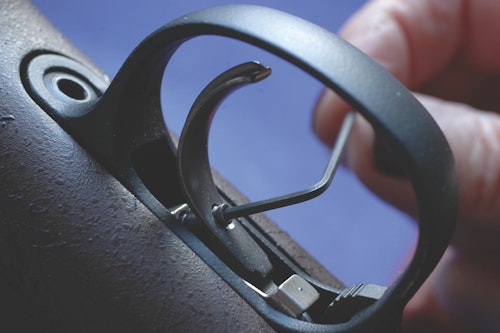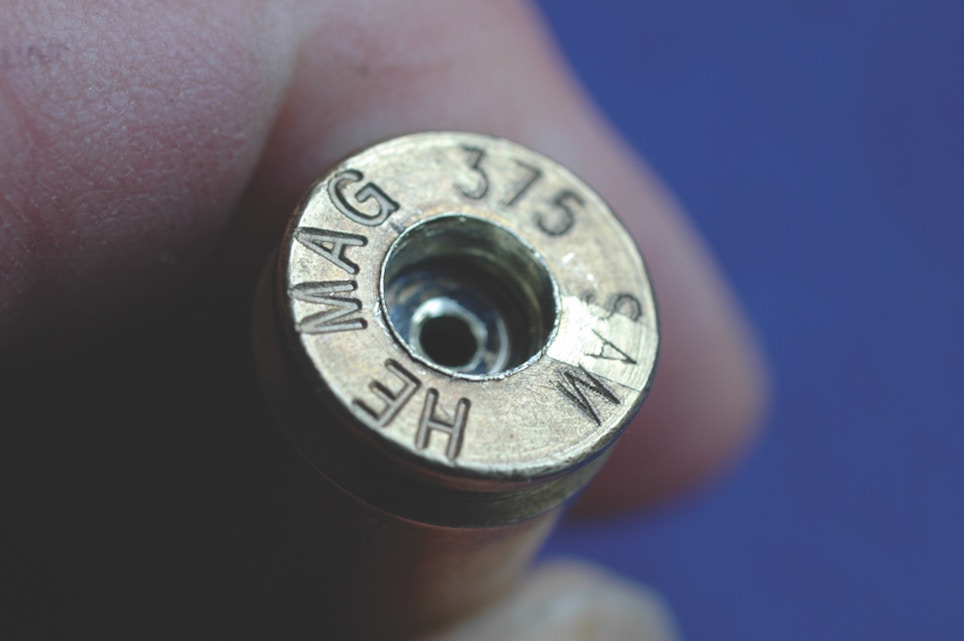“It has a swelled chamber.” He was bent and sallow and thin-lipped, with gnarled hands and an apron as oil-stained as his bench. Over round spectacles, taped at the bridge, his eyes held neither mirth nor question. New cases had separated at their first firing. I’d paid $15 for the rifle. “Take it back,” he snarled. I hurried off, took the rifle back, got $15 on a $30 replacement. Problem solved.
Not long thereafter, someone told me chambers swell about as often as ostriches bear live young. Later I learned that auxiliary SMLE bolt heads came in four sizes, .620 to .640 long, and that war-weary rifles whose bolts had set back could be revived with an up-sized bolt head. I banged my brow with my palm. Headspace! Why hadn’t I thought of that?
But in those days, headspace was as broadly understood as nuclear fission. A new bolt head, had one been available for my early rifle, might not have helped. Samples of more than 200 bolt heads for later SMLEs varied so much in dimensions as to overlap three sizes. Also, these British infantry rifles were chambered to accept ammo hewing to “war-time” specs, with battlefield grit thrown in. Ignorance spared me the hand-wringing over details. It blessed me with a blissfully simple, if not painless, solution. In those days $15 was a lot of money. Many moons later, I’ve fewer rifle problems. Partly that’s because Sears and Montgomery Ward no longer sell surplus infantry arms by the pickle barrel. Commercial rifles are quite trouble-free. Not that whining has gone away.
“This thing won’t shoot.” Meaning: “My shots aren’t going into one hole.” Blame manufacturers who guarantee half-minute knots, and rifle reviewers hailing their best groups as average. Shooters have been conditioned to expect the improbable. Hunting rifles that routinely put three shots into an inch at 100 yards were once revered. That’s still fine accuracy — even for “varmint” and “predator” versions — if not accepted precision at long-range matches. Superior shooting requires much of a marksman. To drill half-inch groups, you must keep muzzle shake during trigger squeeze to about 1/300th of an inch. While adjusting or replacing a rough, heavy trigger will reduce shudder, “rock-steady” hold is hard to achieve! Your rifle meets standards you can’t. “Dimensional uniformity in rifling is key to accuracy,” one barrel-maker told me. “Lapping with abrasive paste on lead plugs can erase microscopic machining marks and relieve tight spots, even if it scrubs off just .0002 of steel.” Acceptable breech-to-muzzle uniformity in bore diameter is typically .0002 for target rifles and .0005 for sporters. An air gauge senses surface variation to 50 millionths of an inch.
Of course, bullets must be as uniform. Sierra’s Rich Maccholz confided that “jacket thickness at the heel of MatchKing bullets must stay within .0003-inch. Tolerance for Sierra GameKing boat-tail and Pro-Hunter flat-base bullets: .0005-inch. Tip run-out limit is identical for match and hunting bullets, at .0001-inch.” Modern barrels and bullets are more uniform than our shot execution. The most likely cause of any “accuracy problem” lies behind the trigger.

Stretching the Barrel
“I’m gonna stretch this baby out.” Firing at steel plates furlongs distant with bullets as long as beer-garden darts makes ballistic sense. Speedy lightweight bullets that zap coyotes to 300 yards fall behind at twice that yardage. But leggy spitzers with alluring ballistic coefficients can require sharper-than-standard rifling twist. A rifle in .338 Norma that shot 250-grain spitzers well for me sent longer, heavier boat-tails into the target sideways. I needed a yardstick to measure 200-yard groups. Even pedestrian factory loads might cry for steeper spin. The 1:12 rifling in Remington’s Model 722 in .244 Rem. was famously too slow to stabilize big-game bullets, while Winchester’s .243 rifles with 1:10 twist shot most of them accurately. Remington quietly renamed the .244 Rem. and changed rifling in “new” 6mm barrels to 1:10. While my first .244 Rem. defied conventional wisdom and shot 90-grain bullets accurately, another I picked up this past year does not like such weighty missiles.
Long bullets that print acceptably tight groups might be on the ragged edge of stability and prone to tumble in flesh. Bullets of traditional profile often deliver the most predictable upset and penetration. Myriad factory loads for popular sub-.270 cartridges give predator hunters many paths to tighter groups. Handloaders have almost limitless options.
I recall having unboxed only four rifles that were intrinsically inaccurate. One, a bolt-action with furniture befitting a tack-driver, spurned even .308 Win. match loads. Assuming it was a lemon, I returned it and got another of the same model. Alas, it also printed groups broad as acorn squash. Back it went. Another time, a costly rifle disappointed me with ho-hum accuracy. But as it was bored for an ancient cartridge slave to out-dated factory loads, I played a hunch and handloaded for it. Sierra bullets instantly delivered a dime-size knot. The jury is still out on a more recent rifle in a new chambering. Factory loads have failed me.
The rare rifle that disappoints is best given a second chance. Try half a dozen loads with bullets of different weights and profiles. If none redeems it, hurry that rifle out the door. While glass bedding can tighten groups, it seldom corrects abysmal accuracy. Worth trying on a rifle you know you’ll keep, it’s a forever change that can affect re-sale value.
Rimfire match ammo is much more accurate than high-velocity Long Rifle loads once peddled at 59 cents a box. The premium for hollowpoint bullets still pays dividends on small game, but sale-priced LR loads with solid bullets shoot accurately enough for informal use. At least, that’s what I thought. The other day in a pistol match, I called a good shot that drilled an oblong hole far from center. Dismissing it as a one-off, I kept shooting. Three of the next 10 shots and six of the next 10 key-holed. “It seems your gun doesn’t like those bullets,” dead-panned a colleague, adding with a sly grin that a shotgun pattern so loose wouldn’t do for late-season roosters. That ammo was lead-free and thus “clean.” It was also useless.

Rimfire Success Story
Rimfire rifles might be our industry’s shiniest success story. Even those turned out like cookies and priced for the proletariat perform well. Ruger’s 10/22 for instance. It appeared half a century ago, in 1964. More than 7 million copies of this endearing .22 self-loader have sold since! “We can produce one every 30 seconds,” said Ron Nelson, 10/22 production supervisor. Every 30 seconds? “Yep. The market absorbs all we can build in two shifts, 20 hours each day.” That was a couple of years ago. Ron conceded the 10/22 cell doesn’t always run at full throttle. Still, this rimfire has a huge fan base. “Accurized” to drill tiny groups in competitive events, it has fueled a thriving cottage industry in aftermarket parts. The 10/22 has been called the most accessorized rifle in the world, though Ron assured me that “spending a grand to trick out a 10/22 won’t make it more reliable. You might even be working against yourself. We’ve had 50 years to comb out nearly every mechanical glitch you can imagine. And the 10/22 was just about glitch-free to begin with.”
Though many shooters applaud its original design, the 10/22 was actually fashioned to replicate, in looks, feel and function, Ruger’s .44 Magnum Carbine. Advertised at its 1959 debut as the Deerstalker, it lost that label in 1962 (after 3,750 units) when Ithaca filed a lawsuit. But the centerfire Carbine handled smartly and had a fetching profile. Its blow-back action and rotary magazine worked reliably. Ruger built it until 1985. The 10/22 has outlived its parent by 35 years and is still a market leader. Including special-order rifles for distributors, Ron told me. “More than 300 configurations of the 10/22 have been sold,” he said.

Other accurate, problem-free rifles also share the stage with rimfire ammunition. About 20 years ago, Hornady engineer Dave Emary showed me a cartridge he’d developed on the .22 WMR case necked for 17-grain .172 polymer-tipped Spitzers. Steve Hornady committed to the .17 HMR (Hornady magnum rimfire), investing heavily with CCI’s rimfire operation, which would form and prime the cases and load them with Hornady bullets. The smallest initial order CCI would accept was 5 million rounds, recalled Dave. “We had to buy the plates to load 1,200 hulls at a time!” All apprehensions vanished when, shortly after the .17 HMR’s debut, Hornady logged orders totaling 12 million cartridges.
My chronograph readings matched the factory’s 2,550 fps almost exactly. Beyond 100 yards, the pointed .17 bullet cut deeply into the .22 WMR’s momentum advantage and stayed supersonic at longer range. Most astonishing was the .17’s accuracy. Three of 10 test rifles I fired yielded sub-MOA averages for five five-shot strings at 100 yards. Predictably, Anschutz and Cooper sporters shot well. But Marlin and Ruger rifles did, too. An inexpensive Savage trounced all comers with a .34-inch group at 100 yards.
Hornady sold 146 million .17 HMR rounds in 2003. I’ve not heard one shooter since complain of sub-standard accuracy. The other day I fired a .5-inch three-shot group from a Marlin sporter in .17 HMR. You needn’t buy a rimfire rifle to get fine accuracy and sure function. But its modest initial cost and affordable, soft-spoken ammo should inspire more shooting. There’s no surer path to tighter groups and hiccup-free handling afield.






